Complete Guide to Software Development Outsourcing 2025
Explore key factors in software development outsourcing, from choosing the right model to measuring success. Start optimising your development strategy today.
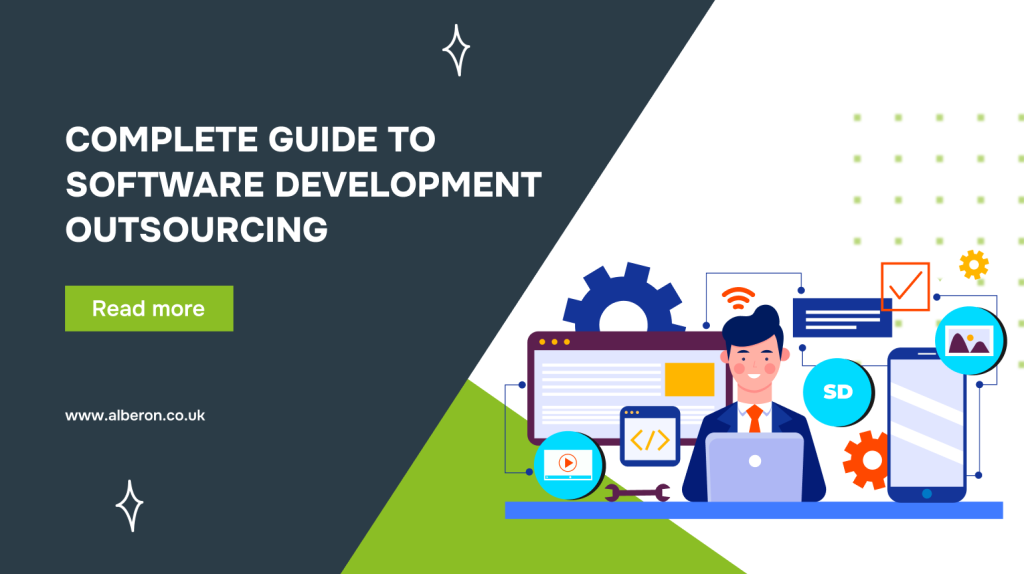
Is managing software development with limited resources or expertise becoming a challenge for your team? This issue is common among businesses facing high costs, tight deadlines, and a need for specialised skills.
Software development outsourcing provides a practical solution. According to a Deloitte survey, 72% of companies outsource software development, with 34% prioritising cost reduction. Outsourcing allows businesses to access global expertise, scale quickly, and avoid the expense of in-house teams.
In this guide, we’ll explore why software development outsourcing is effective, the different models available, and how to decide if it’s the right approach for your business.
TL;DR
- Outsourcing software development provides access to global talent, improving expertise and speed.
- Clear objectives and scope prevent misalignment, ensuring the project stays on track.
- Choosing the right vendor is key to success; focus on experience, expertise, and communication.
- Regular milestone reviews and testing ensure high-quality delivery and timely project completion.
Understanding Software Development Outsourcing and Its Models
Software development outsourcing involves contracting external teams or vendors to handle software development tasks that would traditionally be managed within the organisation. This method allows businesses to access specialised skills, reduce costs, and accelerate project timelines.
Depending on the needs, different outsourcing models can offer distinct advantages. Let’s explore the different types of software models and when each one is most beneficial.
- Offshore Outsourcing: Offshore outsourcing involves partnering with teams in distant countries, often where labour costs are lower. This model is ideal for projects with long timelines and limited budgets. Example: A UK-based company might outsource development to Eastern Europe or India to reduce costs while maintaining a high level of expertise.
- Nearshore Outsourcing: Nearshore outsourcing uses vendors in countries that are geographically closer, often in similar time zones. This model suits businesses needing more collaboration and quicker communication. Example: A UK company might outsource development to Spain or Poland, benefiting from lower costs than domestic hiring but with easier coordination.
- Onshore Outsourcing: It involves hiring teams within the same country. It’s ideal for businesses that prioritise security or have strict regulatory requirements.Example: A UK-based financial institution may choose to outsource software development to a local development firm to allow compliance with data protection regulations like GDPR.
- Staff Augmentation: This model hires external developers who work alongside an in-house team, effectively becoming a part of the internal workforce. It is useful when businesses need to scale their team quickly for specific skills. Example: A software company needing additional developers for a tight deadline might use staff augmentation to meet project demands.
- Dedicated Development Team: A dedicated development team works exclusively on your project, usually under your direction, but from an external location. This is suitable for long-term, complex projects where ongoing development is required. Example: A large-scale enterprise project may benefit from a dedicated team that can handle the continuous development and maintenance of the system.
Understanding outsourcing models helps businesses select the best fit for their requirements, ensuring effective development. The next step in making an informed decision is understanding when to choose outsourcing.
Choosing the Right Approach: Outsourcing vs In-House Software Development
Choosing between outsourcing and in-house software development depends on your project’s specific needs, such as expertise, budget, and time constraints. Outsourcing offers cost savings, while in-house development provides more control over the product.
To determine the right approach, it’s essential to evaluate when outsourcing is the best option compared to the benefits of in-house development.
| Parameter | Outsourcing Development | In-House Development |
| Cost | Typically lower due to access to global talent and lower wages. | Higher due to salaries, benefits, and overhead costs. |
| Expertise | Access to specialised skills and global talent. | Limited to the internal team’s skills and experience. |
| Control | Less control over the development process and team. | Full control over project scope, team, and timelines. |
| Communication | Possible delays due to time zone differences and language barriers. | Easier communication and real-time collaboration. |
| Flexibility | Highly flexible and can scale up or down quickly based on needs. | Less flexible as it requires additional hiring and training. |
| Time to Market | Often faster due to ready availability of expertise. | Can be slower, as teams may need more time to develop. |
| Risk Management | Risk of intellectual property theft and security breaches. | Lower risk as everything is managed internally. |
Outsourcing and in-house development each have unique advantages based on expenditure, expertise, and control. Knowing the essential steps in outsourcing helps ensure successful project outcomes.
What are the Essential Steps in Software Development Outsourcing?

Outsourcing software development involves careful planning and clear communication to avoid common mistakes like misaligned expectations and delays. By following structured steps, businesses can ensure a smooth partnership, meet deadlines, and achieve desired outcomes. Here are the steps involved:
Step 1: Define Clear Objectives and Scope
Determine the goals and deliverables upfront. Without a clear understanding of what you’re aiming for, it’s easy to misalign expectations, leading to delays.
- Break down the end product into features and functionalities that will deliver value to your business.
- Outline the key phases of the project, ensuring all stakeholders know when to expect deliverables and progress updates.
- Define exactly what’s included and what’s not in the project. This helps keep the project on track.
Step 2: Choose the Right Outsourcing Model
The model you choose affects your communication, timeline, and the level of control you have over the project. Consider factors like budget, timeline, and complexity.
- For short-term or less complex tasks, offshore outsourcing may work. For larger projects, a dedicated team or nearshore model may be more suitable.
- Choose a contract type that aligns with your project scope and flexibility needs. For example, fixed-price contracts suit well-defined projects.
- Ensure the model you choose fits the expertise and operational style of the vendor.
Step 3: Prepare Detailed Project Documentation
Clear and detailed documentation ensures that all stakeholders, including the outsourcing team, understand the requirements and expectations.
- Outline objectives, timelines, resources, and expectations. This document will guide the entire project, ensuring everyone is on the same page.
- Detail the technologies, platforms, and frameworks that will be used. This ensures the vendor understands the technical requirements upfront.
- Specify who is responsible for each aspect of the project. This clarifies accountability and helps track progress efficiently.
Step 4: Select the Right Vendor
Choose the right partners based on their specialisation, reliability, and ability to meet your project outcomes.
- Check their work portfolio and ask for case studies that demonstrate their ability to deliver similar projects.
- Look for customer testimonials, references, and online reviews to gauge the vendor’s reliability.
- Consider how time zone differences may impact communication and timelines, especially for ongoing collaborations.
Step 5: Establish Communication Channels
Clear channels ensure that issues are addressed promptly, progress is tracked, and feedback is received on time.
- Schedule weekly or bi-weekly meetings to check progress, discuss issues, and ensure alignment, to keep the project on track.
- Use management tools like Jira, Trello, or Slack to track tasks, share updates, and communicate efficiently.
- Agree on how often reports will be provided and the format they should take. This provides full visibility into the project’s status.
Step 6: Define Security and Confidentiality Measures
Establishing clear security and confidentiality measures will protect sensitive data and intellectual property during the outsourcing process.
- Ensure that the outsourcing vendor signs non-disclosure agreements (NDAs) and contracts that outline data protection and confidentiality requirements.
- Use encrypted communication tools and secure file-sharing systems to ensure all sensitive information is protected during the project.
- Make sure the vendor complies with UK data protection laws such as the GDPR and the Data Protection Act 2018.
Step 7: Set Milestones and Deadlines
Without clear milestones and deadlines, projects can easily fall off track, leading to delays and inefficiencies.
- Divide the project into sub-tasks, each with its own deadline. This makes it easier to track progress and address issues early.
- Work with the vendor to create a realistic timeline that takes into account resources, complexity, and potential obstacles.
- Ensure the vendor meets each milestone by scheduling regular check-ins. This helps you make adjustments as needed.
Step 8: Review and Test Deliverables Regularly
Regular reviews and testing of deliverables will ensure that the project satisfies your expectations and stays aligned with the agreed requirements.
- Integrate testing into the project schedule at regular intervals to identify any issues early.
- Engage relevant stakeholders during review sessions to provide direct feedback and ensure that the product will meet business needs.
- Include both functional (how the product works) and non-functional (performance, security) testing to make the product ready for launch.
Looking for expert help in website design or Google Workspace integration? With Alberon’s expertise, we deliver tailored solutions to bring your projects to life.
Setting milestones and regularly reviewing deliverables ensures your project stays on track.With these steps in place, it’s essential to recognise the advantages that outsourcing software development brings to your business.
Benefits of Software Development Outsourcing
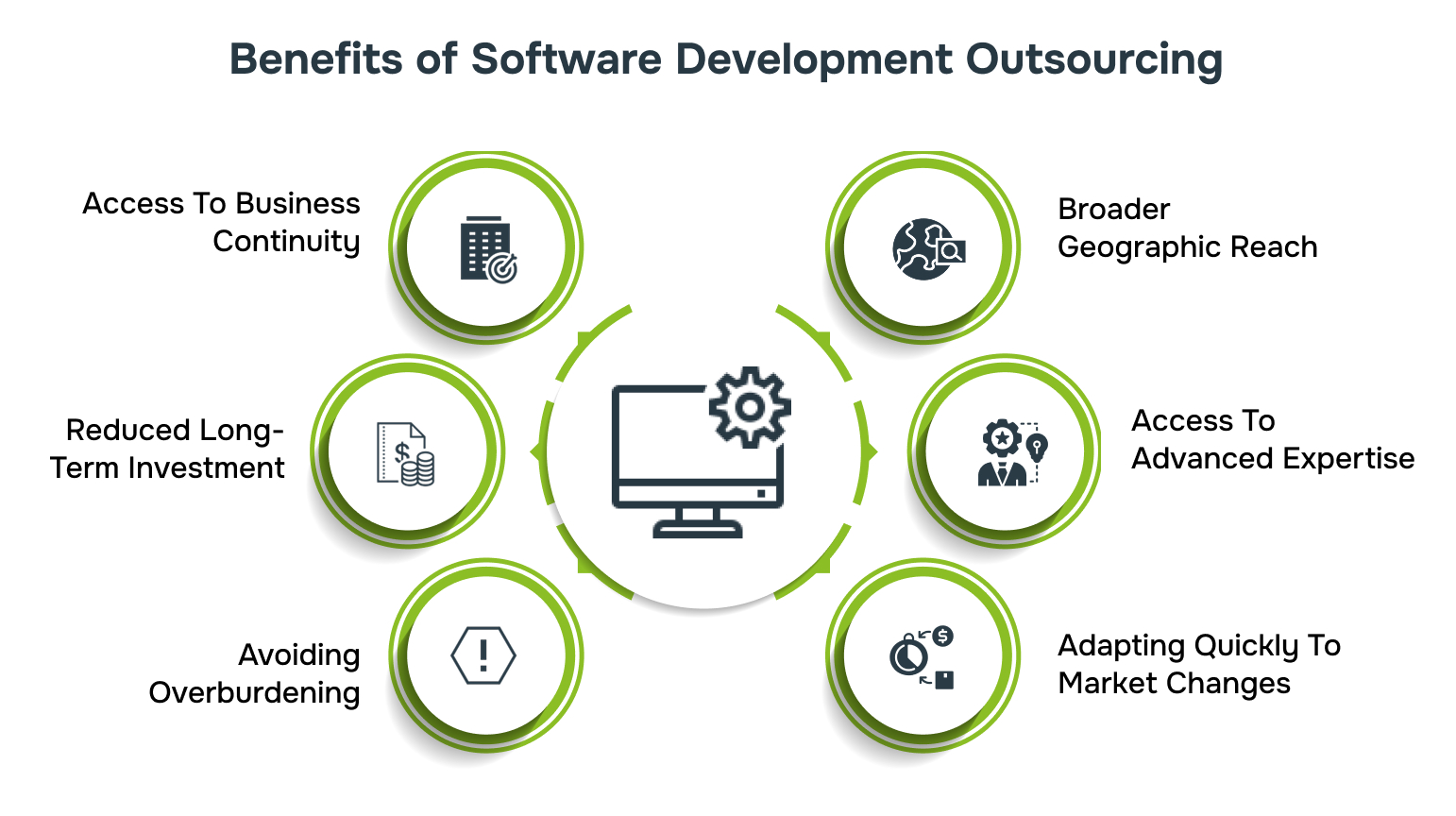
Businesses struggle with resource constraints, tight timelines, and finding skilled talent for complex software projects. Outsourcing software development can alleviate these challenges by bringing in the right expertise and freeing up internal teams to focus on core functions. Let’s explore how this benefits your business.
- Broader Geographic Reach: Outsourcing can provide regional insights that allow software to be customised for specific local markets, boosting relevance.Example: A global e-commerce company outsources development to a team in Brazil to adapt their platform for the South American market, improving user experience.
- Access to Advanced Expertise: By outsourcing, businesses gain access to the latest technologies without investing heavily in training or infrastructure.Example: A fintech company outsourcing to a vendor with expertise in blockchain can implement new features without upskilling its in-house team.
- Faster Response to Changing Market Demands: Outsourcing provides the agility to quickly shift focus or modify the project as market conditions change.Example: A company outsourcing its app development can easily pivot the development direction based on user feedback without reorganising internal resources.
- Avoiding Overburdening: Outsourcing allows businesses to relieve in-house teams from being overwhelmed with additional workloads during peak periods.Example: A software company can outsource development tasks to meet deadlines while allowing in-house teams to focus on their core work.
- Reduced Long-Term Investment: Outsourcing allows businesses to manage development without the need for complex, long-term infrastructure management.Example: A startup can outsource the development of its SaaS platform, avoiding the need to establish a large IT infrastructure or hire full-time developers.
- Access to Business Continuity: Outsourcing partners often have established disaster recovery plans in place, which can help mitigate downtime.Example: An international corporation outsourcing software services benefits from a vendor’s backup systems that ensure minimal service disruption during a crisis.
Outsourcing brings access to global talent, but without clear planning, it can lead to missed deadlines. Understanding the common mistakes made in outsourcing helps you avoid costly errors and ensures a successful collaboration.
Common Mistakes to Avoid While Outsourcing Software Development
Outsourcing software development can be highly beneficial, but mistakes during the process can lead to failures and unsatisfactory results. Identifying potential pitfalls early helps mitigate risks and ensures smoother project execution. Common mistakes include:
| Mistake | Description | Tips to Avoid |
| Unclear Project Scope | Undefined requirements can cause delays in delivery. | Clearly communicate the project scope and deliverables upfront. |
| Choosing the Wrong Vendor | Selecting a vendor without the right expertise or reliability. | Evaluate vendor experience, portfolio, and references thoroughly. |
| Overlooking Legal and Security Risks | Failing to ensure compliance and data protection can cause legal issues. | Draft clear NDAs and contracts, ensuring proper data protection measures. |
| Underestimating Hidden Costs | Outsourcing may lead to unforeseen expenses. | Set a clear budget and keep track of all costs from the start. |
| Lack of Post-Launch Support | Not planning for maintenance can leave the product unsupported. | Agree on post-launch support and maintenance terms in advance. |
Addressing key challenges upfront allows businesses to maintain control and achieve their development goals on time. The next critical step is selecting the right outsourcing partner.
How to Choose Your Software Outsourcing Vendor?
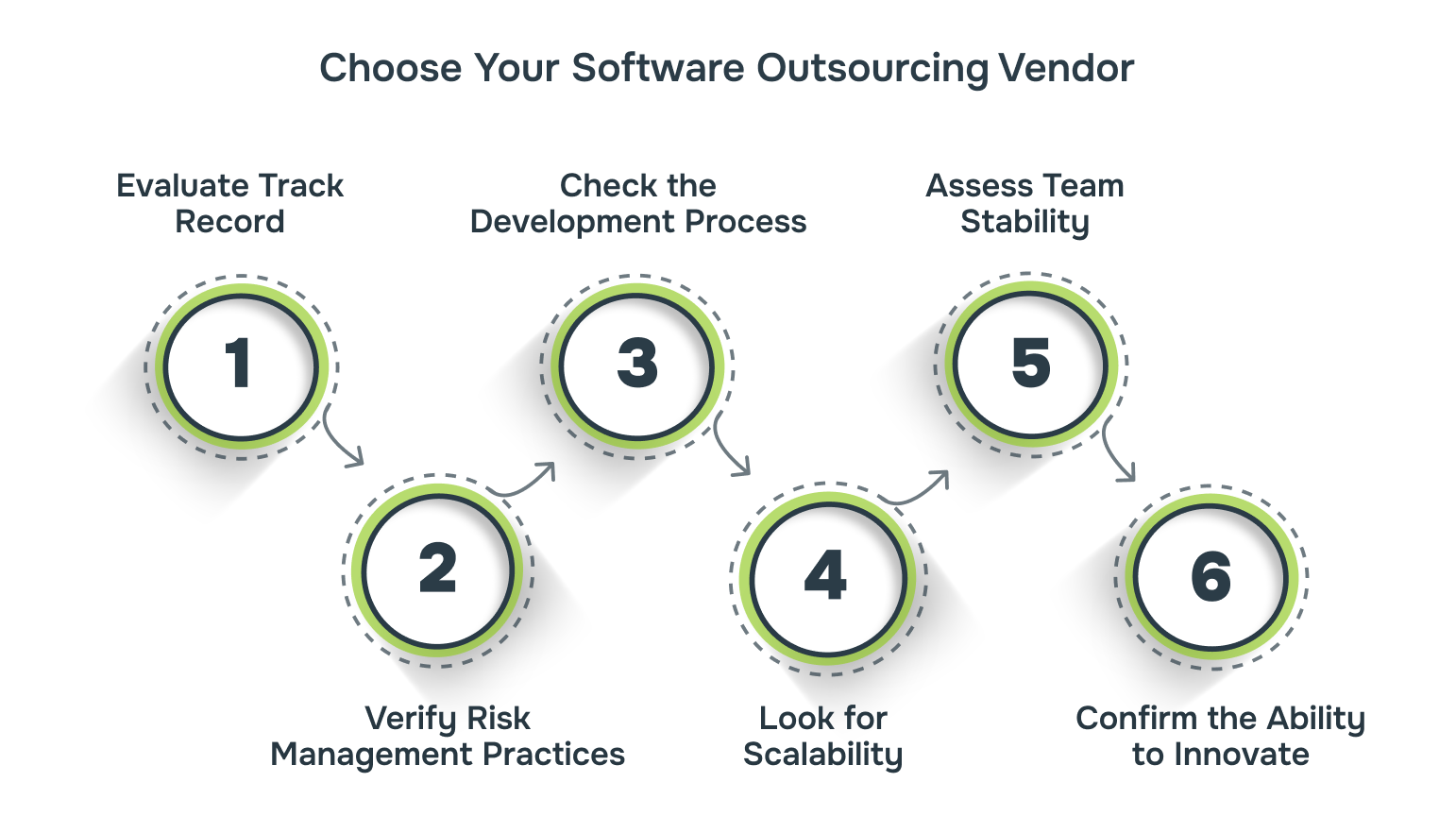
Selecting the right software outsourcing vendor is crucial to avoid low-quality results and non-customised output. Without a structured evaluation process, the risk of mismatched expectations increases significantly.
To ensure a successful partnership, follow a strategic approach in evaluating potential vendors. The following steps show the key areas to focus on:
- Evaluate Track Record: Request detailed case studies that demonstrate their ability to handle projects of your scale and complexity. This helps verify their capacity to meet your specific needs.
- Verify Risk Management Practices: Ensure they have established protocols for handling issues like scope changes, unexpected delays, and technical challenges.
- Check the Development Process: Check if the vendor follows a development methodology, such as Agile or Scrum. This allows for transparent progress tracking, quick changes, and regular reviews to ensure alignment with your goals.
- Look for Scalability: Verify their ability to allocate additional resources quickly without compromising the quality or timelines.
- Assess Team Stability: Reliance on junior-level developers can cause delays and impact quality. Ensure the vendor has a stable team, with experienced professionals who will stay committed to your project.
- Confirm the Ability to Innovate: Choose a vendor that offers creative solutions and is up-to-date with the latest technologies. Ask about their experience with new technologies that could give your project a competitive edge.
Just like selecting the right vendor is crucial before outsourcing, Alberon’s expertise in Microsoft 365 solutions can ensure customisation for your needs. Contact us today!
Focusing on areas like scalability and experience will lead to a smoother project execution and better outcomes. Once you’ve selected the right vendor, it’s important to measure the success of the outsourcing strategy.
Measuring the Success of Software Outsourcing Development
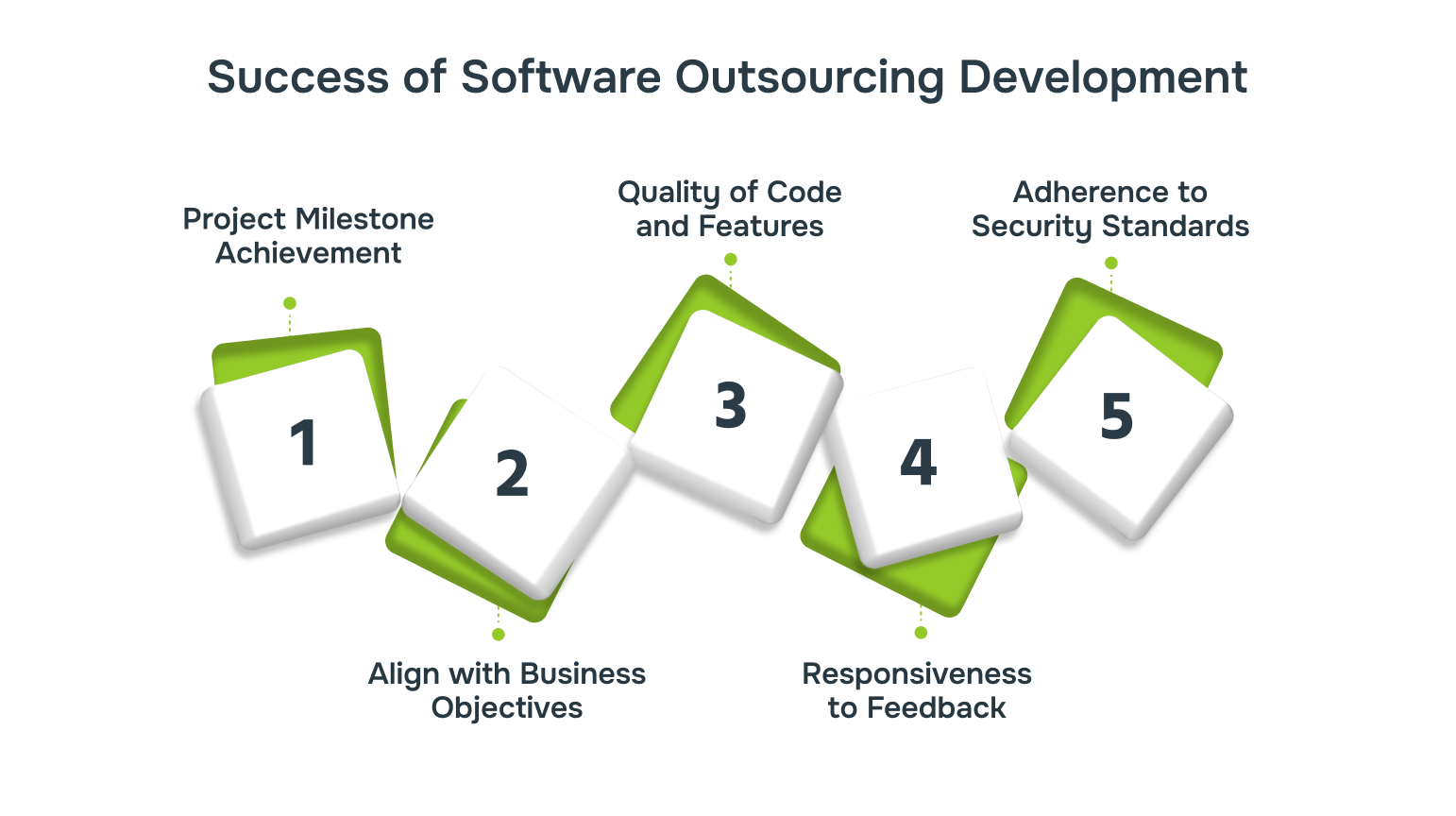
Measuring the success of software development outsourcing is critical for ensuring that your investment delivers real value. Without tracking key performance indicators, you risk misaligned expectations and unmet business objectives. Below are specific metrics to evaluate the performance of your outsourcing partnership.
- Project Milestone Achievement: Track the completion of predefined milestones and whether the project stays on course.Tip: Define clear milestones and hold regular review meetings to ensure progress aligns with expectations.
- Alignment with Business Objectives: Measure whether the final product aligns with the initial business goals and solves the problem it was intended to address.Tip: Regularly revisit your project goals with the vendor to ensure they remain aligned with your business priorities.
- Quality of Code and Features: Poor code quality or missing features can lead to future maintenance issues and additional costs.Tip: Implement regular code reviews and user testing during development to catch issues early.
- Responsiveness to Feedback: Lack of responsiveness can lead to delays and frustrations, undermining the project’s success.Tip: Establish a clear feedback loop with timelines for addressing concerns to ensure swift action.
- Adherence to Security Standards: Monitor whether the outsourced team adheres to necessary security protocols and compliance requirements, such as GDPR. Tip: Conduct regular audits and ensure the vendor is up-to-date on security certifications and compliance regulations.
Focusing on key metrics like milestone achievement can effectively assess the performance of outsourcing partnerships. Real-world examples of outsourcing projects can provide insights into how these strategies lead to positive outcomes.
Examples of Successful Software Development Outsourcing
Outsourcing software development offers great potential, but businesses may struggle with managing remote teams. Learning from companies that have successfully outsourced can provide clear, actionable insights to achieve tangible results.
1. How Slack outsourced its software development and succeeded?
Slack struggled to scale its product quickly due to limited internal resources and the need for rapid development of features.
It outsourced the development of its logo, marketing website, and parts of its app to MetaLab, enabling quick updates and focusing internal resources on core functionalities.
By outsourcing, Slack could focus on building the core features while ensuring that backend infrastructure was handled by external developers. This allowed them to scale quickly and reduce time-to-market.
2. WhatsApp succeeds by outsourcing
WhatsApp initially had limited resources to develop a highly scalable and secure messaging platform that could handle millions of users.
The company outsourced key development components to a small team in Russia, which helped them develop the core technology without overhead or delays.
The outsourcing allowed WhatsApp to scale rapidly and focus on user acquisition and growth, while the outsourced team focused on technical infrastructure and security.
How Alberon Can Help You Develop Customised Software?
Alberon guides your business through the entire software development process, ensuring your project is tailored to meet your unique requirements and business goals.
- Customised Software Solutions: Alberon designs and develops customised software for your specific needs.
- Structured Development Teams: We establish dedicated teams with the right skill set to handle your project.
- Ongoing Support and Maintenance: Our support doesn’t end with deployment. We offer continued support to address future issues.
- Security and Compliance: We incorporate best practices for security, ensuring that your customised software meets standards like GDPR.
- Training and Knowledge Transfer: We provide training to your team, ensuring they know how to use and manage the customised software effectively.
Conclusion
Developing customised software is a game-changer for businesses that want to stay ahead of the curve. It’s about creating something that fits your business needs and helps you grow without worrying about adapting to generic solutions.
At Alberon, we don’t just build software; we work with you to craft a solution that makes sense for your business. It’s all about delivering something that works the way you need it to.
If you want software that truly fits your needs, contact Alberon today. We’re here to help you make it happen!
FAQs
Q. How can outsourcing reduce software development costs?
A: Outsourcing helps cut costs by letting you tap into talent from regions with lower wages. You avoid the overhead of hiring full-time employees and can scale your team up or down as needed.
Q. What are the risks related to outsourcing software development?
A: Risks include communication gaps, security issues, or poor quality work. To avoid these, set clear expectations, stay in regular contact with your team, and use strong security measures to protect your data.
Q. How can I make sure the quality is up to standard with outsourced software?
A: Keep the quality in check by setting milestones, having regular check-ins, and doing frequent testing. Make sure your vendor understands your standards before beginning.
Q. What should I look for when picking an outsourcing partner?
A: Look for a partner who gets your project’s goals, has the right skills, and has proven experience in similar projects. Also, check their reputation and how well they communicate.
Q. How does outsourcing speed up the development process?
A: By bringing in a team of specialists, outsourcing lets you move faster. You need not wait for your internal teams to learn or catch up. The outsourcing partner can start immediately, saving you valuable time.
Get in Touch Today:
Ready to Improve your Business Productivity
Get a trusted partner to navigate your digital transformation. With Alberon, you can ensure a smooth transition, clear communication, and peace of mind.
